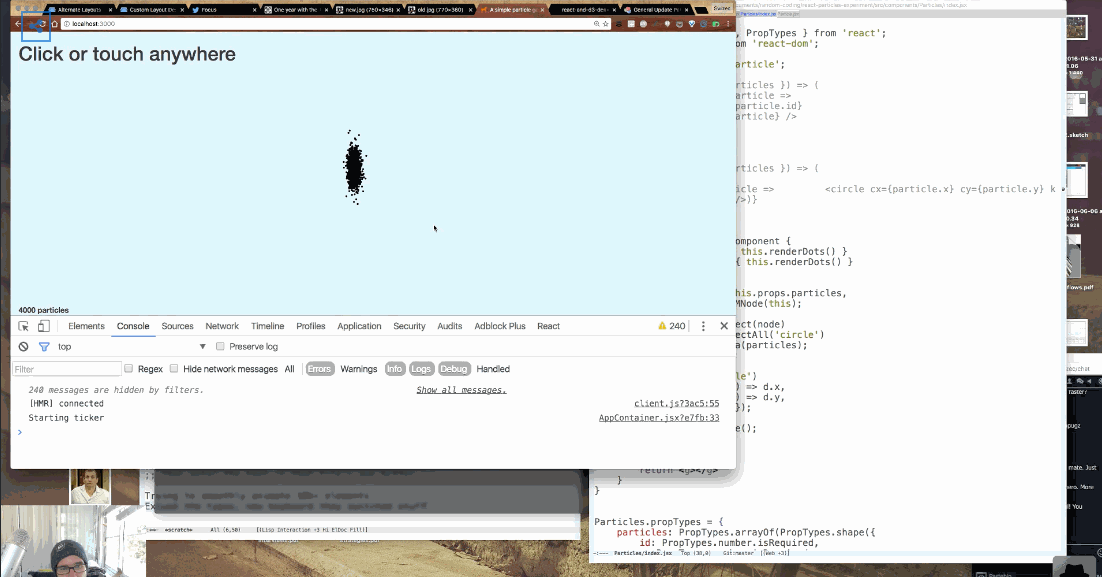This is a Livecoding Recap - an almost-weekly post about interesting things discovered while livecoding. It is shorter than 500 words. There are pictures. You can follow my channel, here. New stuff shows up almost every Sunday at 2pm PDT. There’s live chat ;)
Welcome to the first Livecoding Recap. This recap is for the 12th live coding. I don’t have an excuse for not recapping before now. It just took me this long to realize “These are fun, and I learn a lot. I should turn them into short blogposts.”
This Sunday, I started a new quest: To find the definitive answer to "How do you smoothly animate 10,000 elements in React?”.
Many people have asked me about this recently, and I realized I couldn’t give them a good answer. The best I could come up with was, “Try to render fewer nodes?”. The issue is that sometimes you really do need that many nodes because you don’t want to sacrifice fidelity.
So I took my old particle generator experiment and started playing around. It doesn’t use a lot of d3, but it does rely heavily on React and Redux.
It works like this:
- React renders
<circle>elements in a loop - Redux holds an array of
[x, y]positions - Trigger a
move particlesaction 60-times per second - Add new particles if mousedown
If you change N particles per loop from 5 to 1,000, all hell breaks loose. Animation grinds to a halt.

To get to the bottom of why this happens, we fired up the profiler. There are two suspects:
- Creating new instances of the particles array 60-times per second
- Rendering those DOM nodes
The profiler wasn’t happy with us:

It seems that “scripting” is the culprit, not rendering. In a 21 second experiment, 18 seconds were spent “scripting”, and less than 2 were spent rendering. Curious.
This implies that copying the array is our big timesink. If this is true, then the fix is simple – use immutable.js. Immutable.js promises to be smart about implementing proper immutable data structures efficiently.
We turned off rendering and kept the array copying. Things became silky smooth.
Curiouser and curiouser.
Looking deeper into the profiler reveals that the problem isn’t data management after all; it’s updating children, either in React or in the DOM.

Interesting.
The next thing to try is finding the bottleneck in updating children. Is it React, or is it the DOM? We can figure that out by replacing React rendering with raw d3 rendering.
This had funny results. Particles didn’t update properly, the animation was glitchy, and there were staleness artifacts galore.
Looks like React does make our lives easier, despite how great d3 is on its own.

But it is faster.
Then we looked at react-motion and react-art, and we decided that they don’t smell like they can solve our problem. Maybe I just need to invest more time into figuring them out.
React-motion did give us a great idea though – use css transformations! The GPU renders those; that has got to be fast, right?
Nope. Not fast.
Looks like we do have to get away from the DOM completely. The most promising library we could find to do that was react-koonva.
I’m sure that next time, we will crack this nut. There will be 10,000 dancing dots on the screen.
It’s gonna be great.
PS: the edited and improved versions of these videos are becoming a video course. Readers of the engineer package of React+d3js ES6 get it for free when it’s ready.
About the Author
Hi, I’m Swizec Teller. I help coders become software engineers.
Story time 👇
React+D3 started as a bet in April 2015. A friend wanted to learn React and challenged me to publish a book. A month later React+D3 launched with 79 pages of hard earned knowledge.
In April 2016 it became React+D3 ES6. 117 pages and growing beyond a single big project it was a huge success. I kept going, started live streaming, and publishing videos on YouTube.
In 2017, after 10 months of work, React + D3v4 became the best book I'd ever written. At 249 pages, many examples, and code to play with it was designed like a step-by-step course. But I felt something was missing.
So in late 2018 I rebuilt the entire thing as React for Data Visualization — a proper video course. Designed for busy people with real lives like you. Over 8 hours of video material, split into chunks no longer than 5 minutes, a bunch of new chapters, and techniques I discovered along the way.
React for Data Visualization is the best way to learn how to build scalable dataviz components your whole team can understand.
Some of my work has been featured in 👇